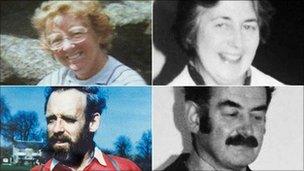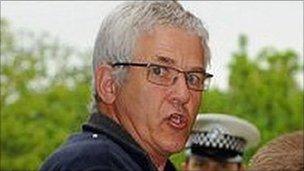John Cooper murder trial told scientific proof 'clear'
- Published

John Cooper denies killing Peter and Gwenda Dixon [both left] and Richard and Helen Thomas
The prosecution in the Pembrokeshire double murder trial has told the jury that "scientific evidence doesn't lie".
Gerard Elias said in his Swansea Crown Court closing speech evidence against John Cooper could not be clearer.
But defence barrister Mark Evans QC described John Cooper as a "soft target" and said there had to be "some concept of fairness in the trial".
John Cooper, 66, denies murdering Richard and Helen Thomas in 1985, and Peter and Gwenda Dixon in 1989.
Mr Cooper is accused of shooting the Thomases at their remote home near Milford Haven in 1985, and holidaymakers Mr and Mrs Dixon, from Oxfordshire, in 1989.
He also denies separate charges of rape, sexual assault and attempted robbery.
Mr Elias said: "We submit to you that the defendant murdered the Thomases, the Dixons and he was the Mount Estate rapist and robber. The evidence against him could hardly be clearer."
"The truth is now as bright and clear as day," he added.
Mr Evans suggested that a man who attacked a group of teenagers on the Mount Estate could have been a poacher.
"Was he a burglar or a lamper?" asked Mr Evans, adding there had to be "some concept of fairness in the trial".

John Cooper denies four murder charges and separate rape and attempted robbery
He was referring to the defendant's previous convictions in 1998, which the jury are aware of and are linked to the charges in this trial.
'Question evidence'
In relation to the Operation Huntsman offences - the investigation that led to Mr Cooper's conviction for a string of burglaries in the 1980s and 1990s - Mr Evans said the jury should "question evidence and think about it".
He described the prosecution's theory that Mr Cooper stored the proceeds of crimes in hedges "as a pretty barmy way to store jewellery".
In referring to possible motivations to the crimes, he said that it had "never been established that he was a compulsive gambler".
With reference to the Scoveston murder, Mr Evans said the prosecution has been "theorising and speculating" about the possible motivations for the killings and he said there were "dangers in theorising".
Mr Evans told the jury that the fact that the defendant had visited Scoveston Park "didn't make him the Scoveston murderer".
Mr Evans also claimed that a man seen by witnesses using Mr Dixon's cash card, "was not a man of Mr Cooper's build or appearance in any way at all".
He also referred to descriptions given of the man who attacked a group of five young people near the Mount Estate.
Mr Evans said the descriptions by the group of young people were of a thin and light man. He said his client weighed around 15st at the time of the attack in March 1996.
With reference to the forensic evidence in the case, Mr Evans said the "DNA evidence appears compelling.." but was "not a certainty".
"If other evidence compels you in another direction, no amount of DNA evidence should sway you," added Mr Evans.
The trial continues.
- Published6 May 2011
- Published22 March 2011